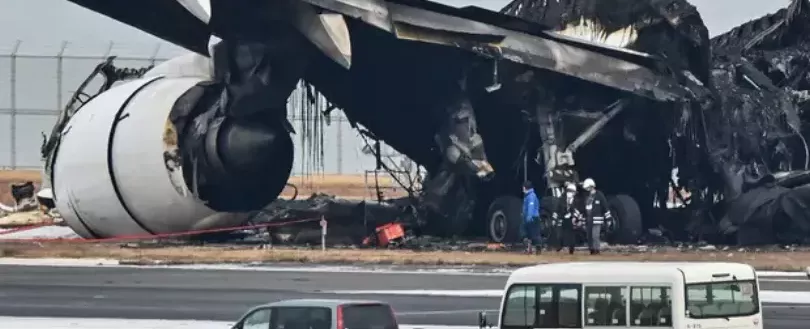
Japan plane crash sparks investigation into fire safety and manufacturing materials
Like it? Share it!
09 January 2024
Aviation experts and investigators are eager to glean insights into the unprecedented incident, which resulted in the first loss of an Airbus A350 since its introduction in 2015 and the initial destruction by fire of an airliner predominantly constructed from carbon fibre.
The aftermath of the collision between a Japan Airlines Airbus A350 and a smaller De Havilland Dash-8 at Tokyo's Haneda airport has set the stage for an in-depth exploration of aircraft safety and emergency response strategies.
Aviation experts and investigators are eager to glean insights into the unprecedented incident, which resulted in the first loss of an Airbus A350 since its introduction in 2015 and the initial destruction by fire of an airliner predominantly constructed from carbon fibre.
While the Japan Transport Safety Board, police, and other official agencies investigate the cause of the collision and the sequence of events, experts commend the remarkable evacuation of the 367 passengers and 12 crew members from the immersed JAL plane. Initial findings suggest challenges such as a malfunctioning intercom system between the flight deck and the cabin and the availability of only three out of eight exit doors due to the external fire.
Ed Galea, a fire safety specialist at the University of Greenwich in London, noted the high-risk nature of the evacuation scenario, particularly with the aircraft's nose angled downwards, impacting the use of inflatable slides. "In these circumstances, every second counts," Galea stressed.
Modern aircraft must demonstrate their ability to evacuate all passengers and crew within 90 seconds using half the available exits, regardless of the challenging conditions. Despite the efficacy of such tests, some experts, including Galea, question their real-world relevance. "I call it a benchmark as it says nothing of the performance of the aircraft in the event of an accident," he commented.
Aircraft cabins, whether constructed from aluminium or the increasingly utilised carbon fibre, are designed to resist external heat for several minutes. Airbus, maker of the A350-900, revealed that composite materials comprised 53% of the aircraft, offering fire resistance comparable to traditional aluminium structures. The incident highlights the resilience of composite structures, particularly in comparison to past incidents involving Boeing 787s with similar materials.
Bjorn Fehrm, an aeronautical engineer and analyst at Leeham News, underlined the industry's shift towards composite materials, driven by the pursuit of reduced weight and increased fuel efficiency. He noted, "In this case, the carbon fibre is giving that heat-shield protection."
The burning images of the JAL A350 further underscore the composite structure's ability to withstand heat for an extended duration. Emile Greenhalgh, professor of composite materials at Imperial College in London, explained that while aluminium melts at around 600 degrees Celsius, composites react differently to fire, forming a char layer that acts as a barrier against the progression of the fire.
In addition to lessons on aircraft materials and evacuation procedures, experts believe that the accounts from both crew and passengers involved in the JAL A350 incident will provide valuable insights into best practices for safety at airports. Despite the tragic loss of lives in the smaller Dash-8 aircraft, the successful evacuation of the JAL flight represents a milestone in the continuous pursuit of enhancing safety standards within the aviation industry.
View the SOURCE here.
Our eNews provides regular insight into industry trends, news headlines, and product and service information. For news articles parallel to those mentioned above, sign up for our eNews. Click here to sign up: Subscribe to our enews (fia.uk.com)
Related news
-
Business Owner Fined for Breaching Fire Safety Legislation
06 October 2025
Related resources
-
Passenger Service Vehicle - Guidance Note
05 September 2023
-
FIA Guidance on Fire Procedures for COVID 19
08 January 2021
